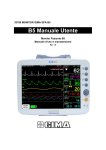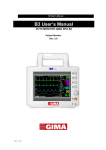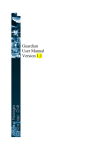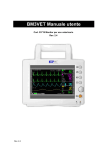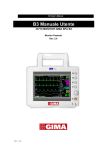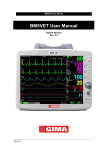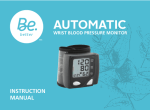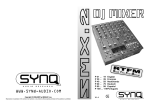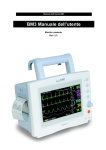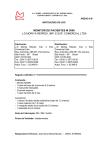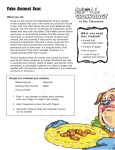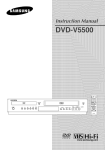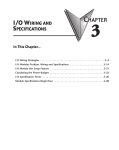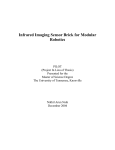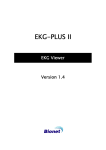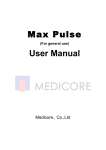Download BM3Plus User`s Manual
Transcript
BM3Plus User’s Manual BM3Plus User’s Manual Patient Monitor Rev. 1.0 Rev. 1.0 BM3Plus User’s Manual Table of Contents BM3Plus User’s Manual ....................................................................................................0 Table of Contents .......................................................................................................................1 1. BASIC.............................................................................................................................7 1.1 CE Standard Information ....................................................................................................8 1.2 Read before Use....................................................................................................................9 How to Contact Us................................................................................................................................. 9 Warranty Period................................................................................................................................... 10 Warning, Caution, Note ....................................................................................................................... 10 General Precaution on Environment ......................................................................................................11 General Precaution on Electric Safety................................................................................................... 16 Cleaning Applied Parts ........................................................................................................................ 18 1.3 Product Components..........................................................................................................20 Product Outline.................................................................................................................................... 20 Principal Characters of Product ............................................................................................................ 20 Product Configuration.......................................................................................................................... 21 Product Options ................................................................................................................................... 21 Product Body Configuration................................................................................................................. 22 Accessories.......................................................................................................................................... 24 Equipment Sign ................................................................................................................................... 25 1.4 Function and Key ...............................................................................................................28 External Function ................................................................................................................................ 28 Operation Key ..................................................................................................................................... 28 1.5 Standard Power Supply Application .................................................................................30 DC Power............................................................................................................................................ 30 1.6 Battery Power Supply Application ....................................................................................31 Operation............................................................................................................................................. 31 The Impact of Lithium-Ion Battery Technology on the Battery ............................................................. 33 Conditioning Guideline........................................................................................................................ 33 Rev. 1.0 1 BM3Plus User’s Manual Storage Guideline ................................................................................................................................ 33 How to Recycle the Battery.................................................................................................................. 33 1.7 General Menu Operation ...................................................................................................34 Screen Composition............................................................................................................................. 34 Menu Selection.................................................................................................................................... 35 Menu Composition .............................................................................................................................. 35 2. PATIENT/DATA MANAGEMENT...............................................................................39 2.1 ADMIT ...............................................................................................................................40 ADMIT TYPE..................................................................................................................................... 40 CHANGE ADMIT INFO..................................................................................................................... 41 DISCHARGE ...................................................................................................................................... 42 ADMIT ............................................................................................................................................... 42 HEIGHT.............................................................................................................................................. 43 WEIGHT............................................................................................................................................. 43 2.2 ALARM ..............................................................................................................................44 Alarm for the Product .......................................................................................................................... 45 ALL LIMITS ....................................................................................................................................... 46 ALARM PRINT .................................................................................................................................. 46 ALARM VOLUME ............................................................................................................................. 47 ALARM LEVEL ................................................................................................................................. 47 PARAMETER LEVEL........................................................................................................................ 48 ALARM REVIEW .............................................................................................................................. 48 ALARM LIST ..................................................................................................................................... 49 SAVING CONDITION ....................................................................................................................... 50 NURSE CALL .................................................................................................................................... 51 3. SETUP..........................................................................................................................52 3.1 SETUP ................................................................................................................................53 DISPLAY............................................................................................................................................ 53 SET PARA .......................................................................................................................................... 54 WAVE SELECT .................................................................................................................................. 54 SET DATE & TIME ............................................................................................................................ 55 SET TIME........................................................................................................................................... 55 SET DATE .......................................................................................................................................... 56 Rev. 1.0 2 BM3Plus User’s Manual HR/PR SELECT.................................................................................................................................. 56 SET SWEEP........................................................................................................................................ 57 DEMO................................................................................................................................................. 57 USER SERVICE ................................................................................................................................. 58 SET UNIT NAME............................................................................................................................... 58 SET BED NUMBER ........................................................................................................................... 59 AC FILTER......................................................................................................................................... 60 SYSTEM............................................................................................................................................. 61 MAKER SERVICE ............................................................................................................................. 61 4. TREND .........................................................................................................................62 4.1 TREND ...............................................................................................................................63 GRAPHIC TREND.............................................................................................................................. 64 TIME PERIOD.................................................................................................................................... 65 TABULAR TREND ............................................................................................................................ 66 TIME INTERVAL............................................................................................................................... 67 TREND WINDOW SETUP ................................................................................................................. 67 TIME PERIOD.................................................................................................................................... 68 SET TREND PARA ............................................................................................................................ 69 TREND PRINT ................................................................................................................................... 69 5. ECG ..............................................................................................................................70 5.1 Introduction........................................................................................................................71 Colors and Standards of Cables ............................................................................................................ 71 Position of ECG Connector and Measuring Cable................................................................................. 71 Attaching Electrodes to the Patient....................................................................................................... 72 Information on the ECG waveform....................................................................................................... 73 5 Position of 5-Lead............................................................................................................................. 74 Position of 3-Lead Wrier Electrode....................................................................................................... 74 How to Attach the NEONATE Electrode .............................................................................................. 75 5.2 ECG Data Window .............................................................................................................76 5.3 ECG Data Setup .................................................................................................................79 TRACE 1 LEAD SELECT................................................................................................................... 79 ALARM LIMIT................................................................................................................................... 80 ALARM SOUND ................................................................................................................................ 81 Rev. 1.0 3 BM3Plus User’s Manual QRS VOLUME ................................................................................................................................... 82 DISPLAY............................................................................................................................................ 82 ECG SPEED........................................................................................................................................ 83 ECG SIZE ........................................................................................................................................... 83 HR SOURCE....................................................................................................................................... 84 ANALYSIS SETTING ........................................................................................................................ 84 6. SpO2 ..............................................................................................................................90 6.1 Outline ................................................................................................................................91 SpO2 Connector Location and Measuring Cable................................................................................... 91 6.2 SpO2 Data Window............................................................................................................92 Signal and Data Validity ...................................................................................................................... 93 6.3 SpO2 Data Setup .................................................................................................................95 RATE VOLUME................................................................................................................................. 95 ALARM .............................................................................................................................................. 96 ALARM LIMIT................................................................................................................................... 96 ALARM SOUND ................................................................................................................................ 97 LEAD FAULT Condition .................................................................................................................... 98 SPO2 Messages ................................................................................................................................... 98 7. RESPIRATION...........................................................................................................100 7.1 Outline .............................................................................................................................. 101 7.2 Respiration Data Window................................................................................................ 102 7.3 Respiration Data Setup ....................................................................................................103 RESPIRATION SPEED..................................................................................................................... 103 RESPIRATION ................................................................................................................................. 104 ALARM ............................................................................................................................................ 104 ALARM LIMIT................................................................................................................................. 105 ALARM SOUND .............................................................................................................................. 106 8. NIBP...........................................................................................................................107 8.1 Outline .............................................................................................................................. 108 8.2 NIBP Data Window.......................................................................................................... 110 8.3 NIBP Data Setup .............................................................................................................. 111 Rev. 1.0 4 BM3Plus User’s Manual ALARM .............................................................................................................................................111 ALARM LIMIT..................................................................................................................................112 ALARM SOUND ...............................................................................................................................113 CUFF SIZE ........................................................................................................................................113 UNIT SELECT...................................................................................................................................114 INTERVAL........................................................................................................................................114 STAT .................................................................................................................................................115 INFLATION.......................................................................................................................................115 9. TEMPERATURE........................................................................................................ 117 9.1 Outline .............................................................................................................................. 118 9.2 Temperature Data Window ............................................................................................. 119 9.3 Temperature Data Setup..................................................................................................120 ALARM ............................................................................................................................................ 120 ALARM LIMIT................................................................................................................................. 121 ALARM SOUND .............................................................................................................................. 122 UNIT SELECT.................................................................................................................................. 122 10. PRINT.......................................................................................................................123 10.1 Print ................................................................................................................................ 124 Printer and Heat Sensitivity Paper ...................................................................................................... 124 Function and Setup Menu .................................................................................................................. 125 10.2 Paper Change ................................................................................................................. 128 11. MESSAGE LIST.......................................................................................................129 12. DEFAULT SETTING VALUE ..................................................................................130 1. Adult-ICU Mode................................................................................................................. 130 2. Neonate-ICU Mode............................................................................................................. 132 3. Pediatric-ICU Mode ........................................................................................................... 134 13. TROUBLE SHOOTING ...........................................................................................136 1. Noise in ECG ...................................................................................................................... 136 2. SpO2 malfunction............................................................................................................... 137 3. Temp malfunction .............................................................................................................. 137 Rev. 1.0 5 BM3Plus User’s Manual 4. NIBP malfunction............................................................................................................... 138 5. Abnormality in NIBP measurements................................................................................. 138 6. Failure in battery recharge ................................................................................................ 139 7. Power failure ...................................................................................................................... 140 8. Periodic noises .................................................................................................................... 141 9. Print failure ........................................................................................................................ 142 14. SPECIFICATION.....................................................................................................143 Ease of use ........................................................................................................................................ 144 Additional Functions.......................................................................................................................... 144 Monitor Environmental Specifications ............................................................................................... 144 Power ................................................................................................................................................ 144 Monitor Performance Specifications................................................................................................... 144 Graphical and Tabular Trends............................................................................................................. 145 ECG capacity..................................................................................................................................... 145 SpO2 capacity .................................................................................................................................... 145 Respiration Performance Specifications.............................................................................................. 146 NIBP capacity.................................................................................................................................... 146 Temperature Unit Performance Specifications .................................................................................... 146 Accessories Included: ........................................................................................................................ 147 Options.............................................................................................................................................. 147 Rev. 1.0 6 BM3Plus User’s Manual 1. BASIC 1.1 CE Standard Information 1.2 Read before Use Warranty Period Warning, Caution, Note General Precaution on Environment General Precaution on Electric Safety Equipment Connection, Maintenance & Washing Equipment Connection 1.3 Product Components Product Outline Principal Characteristics of Product Product Configuration and Product Options Product Body Configuration 1.4 Function and Key External Function Operation Key 1.5 Standard Power Supply Application 1.6 Battery Power Supply Application 1.7 General Menu Operation Screen Composition Menu Selection Menu Composition Rev. 1.0 BM3Plus User’s Manual 1.1 CE Standard Information Electromechanical safety standards met: - EN 60601-1: 1990 + A1:1993 + A2: 1995 Medical Electrical Equipment, Part 1, General Requirements for Safety. - IEC/EN 60601-1-2 :2001 Electromagnetic compatibility -Requirements and tests. - EN 1060-1:1995 Non-invasive sphygmomanometers - Part 1: General requirements - EN 1060-3:1997 Non-invasive sphygmomanometers - Part 3: Supplementary requirements for electro-mechanical blood pressure measuring systems - EN ISO 9919:2005 Medical electrical equipment - Particular requirements for the basic safety and essential performance of pulse oximeter equipment for medical use (ISO 9919:2005) - EN 60601-2-27:2006 Medical electrical equipment - Part 2-27: Particular requirements for the safety, including essential performance, of electrocardiographic monitoring equipment - EN 60601-2-30:2000 Medical electrical equipment - Part 2-30: Particular requirements for the safety, including essential performance, of automatic cycling non-invasive blood pressure monitoring equipment - EN 12470-4:2000 Clinical thermometers - Part 4: Performance of electrical thermometers for continuous measurement - EN 60601-2-49:2001 Medical electrical equipment - Part 2-49: Particular requirements for the safety of multifunction patient monitoring equipment Rev. 1.0 1.BASIC 8 BM3Plus User’s Manual 1.2 Read before Use BIONET services are always available to you. The following are addresses and phone numbers for information, services, and product supplies. How to Contact Us Product Supply Bionet America Inc. Information 2691 Dow Ave Ste B Tustin, CA 92780 Phone : 714-734-1760 Fax : 714-734-1761 E-mail : [email protected], Consumable Supplies Request A/S and Technical Support Phone : 714-734-1760 - USA Phone : 82-2-6300-6477 - Intenational For any technical inquiries or repair on the equipment, Phone : 714 -734-1760 E-mail : [email protected] Home Page URL : http://wwwbionetUS.com ※ In the event of malfunction or failure, contact us along with the model name, serial number, and product name of the equipment. ※ If you need the supply circuit diagram, component list, description and calibration instruction etc. you can contact us and we will provide you with it. Rev. 1.0 1.BASIC 9 BM3Plus User’s Manual Warranty Period This product is manufactured and passed through strict quality control and through inspection. We provide a 1-year warranty period for main body, with 6 months warranty for accessories. We will repair or replace any part of the BM3Plus found to be defective in usual operating circumstance for free to you. This warranty does not apply to any defect caused by improper use, misuse or abuse. Warning, Caution, Note For special emphasis on agreement, terms are defined as listed below in user’s manual. Users should operate the equipment according to all the warnings and cautions. Rev. 1.0 1.BASIC 10 BM3Plus User’s Manual Warning To inform that it may cause serious injury or death to the patient, property damage, material losses against the “warning” sign Caution To inform that it may cause no harm in life but lead to injury against the “caution” sign Note To inform that it is not dangerous but important “note” sign for proper installation, operation, and maintenance of the equipment. General Precaution on Environment - Do not keep or operate the equipment in the environment listed below. Rev. 1.0 1.BASIC 11 BM3Plus User’s Manual Avoid placing in an area exposed to moisture. Avoid exposure to direct Do not touch the equipment sunlight with wet hands. Avoid placing in an area where there is a high variation Avoid using or storing in of temperature. the vicinity of Electric Operating temperature heaters ranges from 10(C to 40(C. Operating humidity ranges from 30% to 85%. Avoid placing in an area where Avoid placing in an area there is an excessive where there is excessive humidity rise or ventilation shock or vibration. problem. Avoid placing in an area where Avoid inserting dust and chemicals are especially metal stored or where there is danger materials into the of gas leakage. equipment Keep the power off Do not disjoint or disassemble when the equipment is the equipment. not fully installed. We take no responsibility for Otherwise, equipment your actions. could be damaged. CAUTIONS Before Installation Compatibility is critical to safe and effective use of this device. Please contact your local sales or service representative prior to installation to verify equipment compatibility. Rev. 1.0 1.BASIC 12 BM3Plus User’s Manual Defibrillator Precaution Patient signal inputs labeled with the CF and BF symbols with paddles are protected against damage resulting from defibrillation voltages. To ensure proper defibrillator protection, use only the recommended cables and lead wires. Proper placement of defibrillator paddles in relation to the electrodes is required to ensure successful defibrillation. Disposables Disposable devices are intended for single use only. They should not be reused as performance could degrade or contamination could occur. Disposal All accessories and/or waste related to this device must be disposed of according to all local regulations. You are responsible for knowing and complying with your local disposal procedures. Electrocute Precautions To prevent skin burns, apply electrocute electrodes as far as possible from all other electrodes, a distance of at least 15 cm/6 in. is recommended. EMC Magnetic and electrical fields are capable of interfering with the proper performance of the device. For this reason make sure that all external devices operated in the vicinity of the monitor comply with the relevant EMC requirements. X-ray equipment or MRI devices are possible sources of interference as they may emit higher levels of electromagnetic radiation. Also, keep cellular phones and other telecommunication equipment away from the monitor. Rev. 1.0 1.BASIC 13 BM3Plus User’s Manual CAUTIONS Instruction for Use For continued safe use of this equipment, it is necessary that the instructions are followed. However, instructions listed in this manual in no way supersede established medical practices concerning patient care. Loss of Data Should the monitor at any time temporarily lose patient data, the potential exists that active monitoring is not being done. Close patient observation or alternate monitoring devices should be used until monitor function is restored. If the monitor does not automatically resume operation within 60 seconds, power cycle the monitor using the power on/off switch. Once monitoring is restored, you should verify correct monitoring state and alarm function. Maintenance Regular preventive maintenance should be carried out annually (Technical inspections). You are responsible for any requirements specific to your country. MPSO The use of a multiple portable socket outlet (MPSO) for a system will result in an enclosure leakage current equal to the sum of all individual earth leakage currents of the system if there is an interruption of the MPSO protective earth conductor. Do not use an additional extension cable with the MPSO as it will increase the chance of the single protective earth conductor interruption. Negligence BIONET does not assume responsibility for damage to the equipment caused by improperly vented cabinets, improper or faulty power, or insufficient wall strength to support equipment mounted on such walls. Rev. 1.0 1.BASIC 14 BM3Plus User’s Manual NOTES Power Requirements Before connecting the device to the power line, check the voltage and frequency. Ratings of the power line must be the same as those indicated on the unit’s label. If this is not the case, do not connect the system to the power line until you adjust the unit to match the power source. In U.S.A, if the installation of this equipment will use 240V rather than 120V, the source must be a center-tapped, 240V, single-phase circuit. Restricted Sale U.S.A federal law restricts this device to sale by or on the order of a physician. Supervised Use This equipment is intended for use under the direct supervision of a licensed health care practitioner. Ventilation Requirements Set up the device in a location which affords sufficient ventilation. The ventilation openings of the device must not be obstructed. The ambient conditions specified in the technical specifications must be ensured at all times. ·Put the monitor in a location where you can easily see the screen and access the operating controls. ·This product is protected against the effects of cardiac defibrillator discharges to ensure proper recovery, as required by test standards. (the screen may blank during a defibrillator discharge but recovers within second as required by test standards.) Interpretive Results Interpretive results are intended only as guidance for the qualified physicians and must not be relied upon as diagnoses. Reference Literature Medical Device Directive 93/42/EEC EN 60601-1/1990 +A1: 1993 +A2 : 1995 : Medical electrical equipment. General requirements for safety EN 60601-1-1/9. 1994 +A1 12.95: General requirements for safety. Rev. 1.0 1.BASIC 15 BM3Plus User’s Manual General Precautions on Electrical Safety Warning BM3PLUS OPERATION MANUAL Check the items listed below before operating the equipment. NOT 1. Be sure that AC power supply line is appropriate to use. (AC100 - 240V) 2. Be sure that the power source is the one supplied from Bionet. (DC18V, 2.5A) 3. Be sure that the entire connection cable of the system is properly and firmly fixed. 4. Be sure that the equipment is completely grounded. (If not, this might cause a problem to occur in the product.) 5. The equipment should not be placed in the vicinity of electric generators, X-ray, broadcasting apparatus to eliminate electrical noise during operation. Otherwise, it may cause incorrect result. Note The Equipment should be placed far from generators, X-ray equipment, broadcasting equipment or transmitting wires, so as to prevent electrical noises from being generated during operation, When these devices are near the Equipment, it can produce inaccurate measurements. For BM3Plus, both independent circuit and stable grounding are essentially required. In the event that the same power source is shared with other electronic equipment, it can also produce inaccurate output. Warning Do not have contact with the patient while operating the machine. It may cause serious danger to the users. Use only the provided cable. Warning In case the Equipment does not operate as usual or is damaged, do not use on patient, and contact a medical equipment technician of the hospital or the equipment supply division. Rev. 1.0 1.BASIC 16 BM3Plus User’s Manual Note BM3Plus is classified as follows: - BM3Plus classifies as Class I, BF & CF concerning electric shock. It is not proper to operate this Equipment around combustible anesthetic or dissolvent. - Noise level is B class regarding IEC/EN 60601-1 and the subject of Nose is B level concerning IEC/EN60601-1-2. Equipment Connection Caution In the hospital, doctors and patients are exposed to dangerous, uncontrollable compensating currents. These currents are due to the potential differences between connected equipment. The safety solution to the problem is accomplished with EN60601-1;1993. Biocompatibility When used as intended, the parts of the product described in this operator manual, including accessories that come in contact with the patient during the intended use, fulfill the biocompatibility requirements of the applicable standards. If you have questions about this matter, please contact BIONET or its representatives. Maintenance and Washing Equipment Connection There are various methods to clean the BM3Plus and its accessories. Please follow the methods mentioned below to avoid unnecessary damage or contamination to the Equipment. We do not repair free of charge regardless of warranty period if it is contaminated or damaged with using dangerous material not approved for washing. Rev. 1.0 1.BASIC 17 BM3Plus User’s Manual Cleaning Applied Parts Cables and Leadwires CAUTION Do not use acetone or ketone solvents for cleaning; do not use an autoclave or steam cleaner. Cables and leadwires can be cleaned with a warm, damp cloth and mild soap, or isopropyl alcohol wipes. For more intensive disinfecting (near sterile) Ethylene Oxide (ETO) is acceptable but will reduce the useful lifetime of the cable or leadwire. CAUTION The decision to sterilize must be made per your institution’s requirements with an awareness of the effect on the integrity of the cable or leadwire. Note The Equipment needs a safety inspection once a year. Please refer to user’s guide or service manual for the examine specifications. Please check carefully both frame and sensor, after cleaning the Equipment, Do not use equipment that is worn out or damaged. At least once a month, clean and wipe off the frame by using a soft cloth after wetting it with water and alcohol. Do not use lacquer, thinner, ethylene, or oxidizer which may lead to damage to the equipment. Make sure both cables and accessories are free of dust or contaminants, and wipe them off with soft cloth wetted with warm water (40°), and at least once a week, clean them by using the clinical alcohol. Rev. 1.0 1.BASIC 18 BM3Plus User’s Manual Do not submerge the accessories under any liquid or detergent. Also, make sure that no liquid penetrates into the Equipment or probes. Caution Do not dispose of single use probe in any hazard place, Always think about environmental contamination. Caution There is a back-up battery on board inside system. When users dispose this battery, Please conform to all local laws and regulations.. Warning Check the electrodes of batteries before changing them. · Operate BM3Plus with internal electric power supply when unsure of external ground connection or installation occur. · Remove the battery when not using equipment for a while to avoid any damage. For other applied parts such as temperature sensors, pulse oximetry probes, and NiBP cuffs, you must consult the manufacturer for cleaning, sterilization, or disinfecting methods. Rev. 1.0 1.BASIC 19 BM3Plus User’s Manual 1.3 Product Components BM3PLUS OPERATION MANUAL Product Outline BM3Plus monitor is a product used for monitoring biological information and occurrence of a patient. Main functions of the product include displaying information such as ECG, respiration, SpO2, NIBP and temperature on its LCD screen and monitoring parameter, and alarming. It also prints out waves and parameters via a printer. Principal Characters of Product BM3Plus is a small-size multifunctional monitoring device for a patient designed for easy usage during movement. It features devices for hanging its handle from the patient’s bed. The equipment also measures major parameters such as ECG, SpO2, NIBP, temperature and pulse, displaying it on a 7-inch color LCD screen. It also enables users to check waves and parameters and other vital signs of a patient via the 58mm thermal printer and monitor the patient by the remote-controlled alarm system. It also enables to build a central monitoring system by linking devices used for separate patients so that one can monitor several patients at a time. Warning Use only the supplement accessories provided by us. Otherwise, patient and user may be exposed to danger. Warning BEFORE USE — Before putting the system into operation visually inspect all connecting cables for signs of damage. Damaged cables and connectors must be replaced immediately. Before using the system, the operator must verify that it is in correct working order and operating condition. Periodically, and whenever the integrity of the product is in doubt, test all functions. Rev. 1.0 1.BASIC 20 BM3Plus User’s Manual Product Configuration 1. Main body of BM3Plus Monitor 1 EA 2. 3-Lead Patient Cable 1 EA (3CBL-400, 3WIRE-400) 3. ECG extension cable 1 EA 4. Disposable electrodes 10 EA (ECGSENS-400) 5. NIBP extension tube 1 EA (NBPCBL-400) 6. Adult cuff (25-35 Cm) 1 EA (ACUFF-400) 7. SpO2 extension cable 1 EA (SPCBL-400) 8. SpO2 Probe (finger type, reusable) 1 EA (SPASENS-400) 9. DC Adaptor (MW160 made in AULT Co., Ltd.) 1 EA Optional Products 1. Temperature Probe (TEMPSENS-400) 2. Printer (PRN-400) 3. Chart Paper (PAPER-400) Warning In order to avoid electrical shock, do not open the cover. Disassembling of the equipment should be done only by the service personnel authorized by BIONET Warning Users must pay attention on connection any auxiliary device via LAN port or nurse calling. Always consider about summation of leakage current, please check if the auxiliary device is qualified by IEC 60601-1, or consult your hospital biomedical engineer. Rev. 1.0 1.BASIC 21 BM3Plus User’s Manual Product Body Configuration Rev. 1.0 1.BASIC 22 BM3Plus User’s Manual ECG Measuring Connector NIBP Measuring Connector Temp. Measuring Connector SpO2 Measuring Connector Rev. 1.0 1.BASIC 23 BM3Plus User’s Manual Accessories ECG Cable + Extension Cable SpO2 Cable + Extension Cable NIBP Cuff+ Extension cable Temperature sensor (Option) Rev. 1.0 1.BASIC 24 BM3Plus User’s Manual Equipment Sign ATTENTION : Consult accompanying documents TYPE CF APPLIED PART : Insulated (floating) applied part suitable for intentional external and internal application to the patient including direct cardiac application. "Paddles" outside the box indicate the applied part is defibrillator proof. Medical Standard Definition : F-type applied part(floating/insulated) complying with the specified requirements of IEC 60601-1/UL 2601-1/CSA 601.1 Medical Standards to provide a higher degree of protection against electric shock tan that provided by type CF applied parts. TYPE BF APPLIED PART : Insulated (floating) applied part suitable for intentional external and internal application to the patient excluding direct cardiac application. "Paddles" outside the box indicate the applied part is defibrillator proof. Medical Standard Definition : F-type applied part (floating/insulated) complying with the specified requirements of IEC 60601-1/UL 2601-1/CSA 601.1 Medical Standards to provide a higher degree of protection against electric shock than that provided by type BF applied parts. Rev. 1.0 1.BASIC 25 BM3Plus User’s Manual Ground Printer Serial Port LAN Port AUX Connector Port DC Input Indicator Battery Operation Indicator DC Input Connector Rev. 1.0 1.BASIC 26 BM3Plus User’s Manual NIBP Temperature Function Power on Power off Respiration ECG Heart Pulse Rev. 1.0 1.BASIC 27 BM3Plus User’s Manual 1.4 Function and Key External Function The front panel of this product consists of an LCD screen and five function keys and one trim knob. Operation Key 1. Power : Switches on and off the Power. 2. Function Key 3. Blood Pressure:Manually completes measuring blood pressure. 4. Printer:Prints out the waves selected from the menu until the key is pressed to stop. 5. Alarm: Stop alarm sound. First press stops the current alarm for one minute Second press stops the all alarm for five minutes. Third press makes the alarm back to the original setting. 6. Trim Knob:This key is used to select menu by turning it clock or anticlockwise to move cursors. Rev. 1.0 1.BASIC 28 BM3Plus User’s Manual Rev. 1.0 1.BASIC 29 BM3Plus User’s Manual 1.5 Standard Power Supply Application DC Power DC Power LED is lighted on when the DC Power is plugged into the inlet at the back of the product. A press of the power key makes the machine ready for use. Warning This equipment must only be connected to an outlet with protected earth. Rev. 1.0 1.BASIC 30 BM3Plus User’s Manual 1.6 Battery Power Supply Application Battery power can be supplied for enabling portable use or for use during DC power failure. Operation 1. Battery Power LED is lighted on when the machine is in use. 2. The DC/battery power is only sustainable for 1 hour. 3. Battery is automatically charged when the machine is connected to DC Power Supply. Battery LED is lighted on after blinking. 4. The charging status of the batteries is displayed with 5 green boxes, each indicating a different charging . ( 0% -> 25% -> 50% -> 75% -> 100%) Battery: LS1865L2203S1PMXZ(11.1V - 2200mA, Li-ion) The Lithium-Ion battery is a rechargeable battery containing Lithium-Ion cells. Each battery contains an integrated electronic fuel gauge and a safety protection circuit. 5. The discharge condition of battery is indicated with on of 5 yellow boxes, each box showing a different level of charge available. . (100% -> 75% -> 50% -> 25% -> 0%) Rev. 1.0 1.BASIC 31 BM3Plus User’s Manual When the battery power remains 25%, the message of “Low Battery” is displayed. The power is automatically cut off after 5 minutes from the appearance of the message. The machine will no longer operate when the “Low Battery” indication is on. Charge the batteries with the power adaptor, which BIONET provided. -Battery charging time: More than 6 hours -Continuous battery use time: Lowest 1 hour to highest 2 hours continuous use (buffering) Warning Check the electrodes of batteries before charging them. 6. Battery status indication: When battery is disconnected from equipment or out of order, it is shown by a red `X' as shown below. Rev. 1.0 1.BASIC 32 BM3Plus User’s Manual The Impact of Lithium-Ion Battery Technology on the Battery The following are the key points you should know about Lithium-Ion battery technology: The battery will discharge on its own, even when it is not installed in a monitor. This discharge is the result of the Lithium-Ion cells and the bias current required for the integrated electronics. By the nature of Lithium-Ion cells, the battery will self-discharge. The self-discharge rate doubles for every 10°C (18°F) rise in temperature. The capacity loss of the battery degrades significantly at higher temperatures. As the battery ages, the full-charge capacity of the battery will degrade and be permanently lost. As a result, the amount of charge that is stored and available for use is reduced. Conditioning Guideline The battery in the monitor should be fully charged and discharged every six months and condition it using the battery charger. Storage Guideline Store the battery outside of the monitor at a temperature between 20°C to 25°C (68°F to 77°F). When the battery is stored inside a monitor that is powered by an AC power source, the battery cell temperature increases by 15°C to 20°C (59°F to 68°F) above the room’s ambient temperature. This reduces the life of the battery. When the battery is stored inside a monitor that is continuously powered by an AC power source and is not powered by battery on a regular basis, the life of the battery may be less than 12 months. BIONET recommends that you remove the battery and store it near the monitor until it is needed for transport. How to Recycle the Battery When the battery no longer holds a charge, it should be replaced. The battery is recyclable. Remove the old battery from the monitor and follow your local recycling guidelines. WARNING EXPLOSION HAZARD DO NOT incinerate the battery or store at high temperatures. Serious injury or death could result. Rev. 1.0 1.BASIC 33 BM3Plus User’s Manual 1.7 General Menu Operation Screen Composition Real Time Wave Parameter Window Windows Menu Select Window Real Time Wave Window:Displays measured results by up to three waves. Menu Select Window:Menus appear when they are activated.. Parameter Window:Measured and setup data are displayed in five windows. Rev. 1.0 1.BASIC 34 BM3Plus User’s Manual Menu Selection Turn or press the knob. When the Trim Knob Key is turned, menus are selected in the order indicated above. The above screen shows that the MORE menus is selected. The menus move to the right in the order of MORE MENU → ECG → NIBP →SpO2 → RESP → TEMP. Menu Composition More Menu Window When the additional menu is selected it will display your available options. Rev. 1.0 1.BASIC 35 BM3Plus User’s Manual Numerical value sign widow This window displays a measured parameter, function setup, and the boundary of parameter values. Parameter Breathing rate value Menu selection by using Trim Knob key As the key is turned to the right, the menu selection moves clockwise. As the key is turned to the left, the menu selection moves counterclockwise. The menu selection is activated when you depress Trim Knob key. Menu selection with arrows Upward Movement: Turns the Trim Knob key to the left. Downward Movement: Turns the Trim Knob key to the right. Selection is made by pressing the Trim Knob key. One exits the menu after the selection. Rev. 1.0 1.BASIC 36 BM3Plus User’s Manual When moving within the quadrilateral, the text color reverses, and the numeric value applies immediately. Word feature menu The following figure shows the screen where the word sequence menu is activated within the word sequence correction menu. Here, the cursor moves over the words when the Trim Knob key is turned in the clockwise direction. The above figure shows how the cursor moves on the screen. The cursor moves according to the direction the Trim Knob Key is turned. Press the Trim Knob key if you want to change a letter currently on the screen. The above figure shows how the cursor is selected to change a letter. Right-hand turning of the Trim Knob Key makes it possible to select in the order of 0-9,A-Z, and a blank, while left-hand turning makes the movement in the opposite direction. Once a letter or a number is selected, the screen comes back to the condition where the same process of selection can be made. One may move to Rev. 1.0 1.BASIC 37 BM3Plus User’s Manual the menu item in the left of the screen to end the process, which is completed by pressing Trim Knob Key. After completion, the screen comes back to the earlier picture. Operation menu The setup value changes without a selection when the menu is moved. Rev. 1.0 1.BASIC 38 BM3Plus User’s Manual 2. PATIENT/DATA MANAGEMENT 2.1 ADMIT CHANGE ADMIT INFO DISCHARGE HEIGHT WEIGHT 2.2 ALARM ALL LIMITS ALARM PRINT ALARM VOLUME ALARM LEVEL ALARM REVIEW ALARM LIST SAVE ALARM LEVEL NURSE CALL Additional setups are made for each parameter function. One can make an overall setup for the entire monitor system. Rev. 1.0 BM3Plus User’s Manual 2.1 ADMIT ADMIT TYPE CHANGE ADMIT INFO DISCHARGE HEIGHT UNIT WEIGHT UNIT DEFAULT SETTING ADMIT TYPE Set the alarm limits environment of equipment in discharge status. Rev. 1.0 2. PATIENT/DATA MANAGEMENT 40 BM3Plus User’s Manual CHANGE ADMIT INFO Last and first name (11 letters for each), sex (male or female), date of birth, weight, height, and patient ID (13 characters) Rev. 1.0 2. PATIENT/DATA MANAGEMENT 41 BM3Plus User’s Manual DISCHARGE Patient information and all numbers change to standard, and the screen displays, “ALL ALARMS OFF ADMIT PATIENT TO ACTIVE ALARMS.” ADMIT Rev. 1.0 2. PATIENT/DATA MANAGEMENT 42 BM3Plus User’s Manual HEIGHT Unit of height is set as Cm / Inches. WEIGHT Unit of weight is set as Kg / LBS. Rev. 1.0 2. PATIENT/DATA MANAGEMENT 43 BM3Plus User’s Manual DEFAULT SETTING Resets the Alarm Limit settings to factory defaults as in 12.DEFAULT SETTING VALUE section. 2.2 ALARM Alarm is divided into two, alarm for the patient’s condition and for the product’s condition. The patient’s alarm sounds when the diagnostic functions are detected. Each alarm sound differs in order and volume according to the levels of HIGH, MEDIUM, LOW and MESSAGE. HIGH -5 ≡ 300 ≡ MEDIUM -3 ≡ 300 ≡ LOW -1 ≡ 300 ≡ ≡ 300 ≡ MESSAGE : Alarm sounds ≡ 300 ≡ : Number flashes : Waves are printed out : Alarm lamp flashes Rev. 1.0 2. PATIENT/DATA MANAGEMENT 44 BM3Plus User’s Manual Alarm for the Product The machine gives alarm sounds for its system with a related message flashing. LOW -1 ≡ Alarm Text ≡ ALARM LIMITS:The machine enables one to see and change the limits of alarm for all parameter functions. ALARM PRINT:with an ON/OFF setup, the related information is printed out whenever an alarm is given. ALARM VOLUME:volume of each alarm can be adjusted in 10 steps. ALARM LEVEL:Priority of each parameter alarm can be set up. ALARM REVIEW: Allows you to review previously saved alarm information and set the save status. NURSE CALL: Set the ON/OFF feature of the NURSE CALL. Rev. 1.0 2. PATIENT/DATA MANAGEMENT 45 BM3Plus User’s Manual ALL LIMITS ALARM PRINT Set ON/OFF functions automatically. When the alarm is activated the corresponding information is printed on heat sensitive paper. Rev. 1.0 2. PATIENT/DATA MANAGEMENT 46 BM3Plus User’s Manual ALARM VOLUME Set the alarm volume to be set at 10 grades. ALARM LEVEL Set the order of priority in each alarm. Rev. 1.0 2. PATIENT/DATA MANAGEMENT 47 BM3Plus User’s Manual PARAMETER LEVEL ALARM REVIEW After an alarm is triggered the alarms and data wave pattern can be reviewed. Set up for priority of each parameter alarm. Rev. 1.0 2. PATIENT/DATA MANAGEMENT 48 BM3Plus User’s Manual ALARM LIST When an alarm activates, this shows the order of the alarms. Rev. 1.0 2. PATIENT/DATA MANAGEMENT 49 BM3Plus User’s Manual SAVING CONDITION This determines the order in which triggered alarms are saved. Rev. 1.0 2. PATIENT/DATA MANAGEMENT 50 BM3Plus User’s Manual NURSE CALL When an alarm is triggered, this activates the NURSE CALL function. Rev. 1.0 2. PATIENT/DATA MANAGEMENT 51 BM3Plus User’s Manual 3. SETUP 3.1 SETUP DISPLAY DEMO USER SERVICE MAKER SERVICE Rev. 1.0 BM3Plus User’s Manual 3.1 SETUP DISPLAY : screen set menu USER SERVICE : This is the menu to set the connection used to interface with an external computer MAKER SERVICE : This is the basic adjustment menu used to adjust the features of this product. DISPLAY SET PARA:Select measurement parameters. WAVE SELECT:Set wave pattern source at the bottom of the WINDOW in LARGE PARAMETER MODE. SET DATE & TIME: Set and change date and time. HR/PR SELECT:Set and select HR/PR source. COLOR SELECT: Set screen display color. SET SWEEP: Set speed of ECG, RESP WAVE DISPLAY Rev. 1. 0 3.SETUP 53 BM3Plus User’s Manual SET PARA Select measurement function to use WAVE SELECT Select waveform to display in large parameter display. Rev. 1.0 3.SETUP 54 BM3Plus User’s Manual SET DATE & TIME It has sub menu to set date and time. SET TIME Set time of equipment. Rev. 1.0 3.SETUP 55 BM3Plus User’s Manual SET DATE Set date of equipment HR/PR SELECT This menu is used to set the source that displays heart and pulse rate. The source can be selected between ECG and SPO2. Rev. 1.0 3.SETUP 56 BM3Plus User’s Manual SET SWEEP Set speed of drawing wave signal pattern in this widow. DEMO Set ON/OFF DEMONTRATION of equipment. Rev. 1.0 3.SETUP 57 BM3Plus User’s Manual USER SERVICE The user is able to set the communication parameters, power supply filter, and unit identification. SET UNIT NAME Set up for Equipment name. Rev. 1.0 3.SETUP 58 BM3Plus User’s Manual SET BED NUMBER Set up for patient bed number. Allowable settings are from 1 to 255. Rev. 1.0 3.SETUP 59 BM3Plus User’s Manual AC FILTER AC FILTER is function where you can set power supply frequency. This feature is required because power supply frequency can be different from one country to another. . (The selectable frequencies are 50Hz and 60Hz.) Rev. 1.0 3.SETUP 60 BM3Plus User’s Manual SYSTEM System able to adjust and verify Equipment version information and system information MAKER SERVICE Maker service is a menu used by manufacturers. Rev. 1.0 3.SETUP 61 BM3Plus User’s Manual 4. TREND 4.1 TREND GRAPHIC TREND TABLE TREND TREND WINDOW SETUP Rev. 1. 0 62 BM3Plus User’s Manual 4.1 TREND TREND shows saved data graphically displayed with numeric values. Real-time data recording duration is 1 minute. Amount of saving time for this data will be for 128hours. : Move to main screen : Move within the tables : Move up to other analysis function : Move down to other analysis function : Time period set menu Rev. 1.0 4.TREND 63 BM3Plus User’s Manual GRAPHIC TREND Wave Data can be stored and seen according to section. Rev. 1.0 4.TREND 64 BM3Plus User’s Manual TIME PERIOD One can set up and store data and time that one can see in a screen. Rev. 1.0 4.TREND 65 BM3Plus User’s Manual TABULAR TREND One can see the stored data at the time previously set up. Rev. 1.0 4.TREND 66 BM3Plus User’s Manual TIME INTERVAL One can store data and set up time. TREND WINDOW SETUP Set the trend display window that will show the real time wave window. Rev. 1.0 4.TREND 67 BM3Plus User’s Manual TIME PERIOD Set visible time period in a screen. Rev. 1.0 4.TREND 68 BM3Plus User’s Manual SET TREND PARA Set parameter for display in a screen. TREND PRINT Graphic: select the number which selects a graphic trend and press print to print the selected trend. Table: select the table number to be print and press print to receive printout of all the data in the selected patient admit (Admit) table. Rev. 1.0 4.TREND 69 BM3Plus User’s Manual 5. ECG 5.1 Outline Color and Name for Each Cable Size ECG Connector Location and Measurement Cable 5 Lead Electrode Attached Location 3 Lead Electrode Attached Location Method to Attach Electrode to Baby 5.2 ECG Data Window 5.3 ECG Data Setup TRACE 1 LEAD SELECT ALARM LIMIT ALARM QRS VOLUME ECG SIZE HEART RATE SOURCE ECG SPEED ANALYSIS SETTING Rev. 1. 0 70 BM3Plus User’s Manual 5.1 Introduction It calculates the heart rate with 3 or 5 leads ECG signal acquisition and perform the alarm according to the setting value. Colors and Standards of Cables AHA AHA IEC IEC Color code Label Color code Label Right arm White RA Red R Left arm Black LA Yellow L Right leg Green RL Black N Left leg Red LL Green F V1(precordial) Brown V1 White C1 Leadwire AHA:American Heart Association (U.S.A. standard) IEC:International Electro technical Commission (Europe standard) Position of ECG Connector and Measuring Cable ECG connecter +detect cable Rev. 1.0 5.ECG 71 BM3Plus User’s Manual Attaching Electrodes to the Patient 1. Shave excess hair. With a piece of cotton pad moistened with alcohol, clean the patient’s skin where the electrodes should be mounted. Avoid wrinkled or uneven skin areas. Wipe off the alcohol with a dry cotton pad. 2. Open the electrode package and take out the electrode. 3. Remove the backing paper from the electrode. Be careful not to touch the adhesive side. 4. Attach the disposable electrode to the previously cleaned skin. Avoid wrinkled and uneven skin areas. 5. Attach the electrode lead which is connected to the monitor onto the electrode. 6. Fasten the electrode lead to the skin with surgical tape with an extra length of wire between the tape and the electrode. This prevents body movement from moving the electrode lead. Note To maintain good contact between the electrode and skin, check that the paste of the disposable electrode is not dry. When contact of the disposable electrode becomes poor, replace the electrode with a new one immediately. Otherwise, contact impedance between the skin and electrode increase and the correct ECG cannot be obtained. If the contact is bad before the expiration date on the package, replace the electrode with a new one. To obtain a stable ECG waveform rub the skin with “skin Pure” skin preparation gel or tincture of Benzoin. Shall use only the CE certified disposable electrode. Rev. 1.0 5.ECG 72 BM3Plus User’s Manual Information on the ECG waveform When ECG signal is 80bpm T-wave duration is 180ms, and the QT interval is 350ms. Rev. 1.0 5.ECG 73 BM3Plus User’s Manual 5 Position of 5-Lead Position of 3-Lead Wrier Electrode Rev. 1.0 5.ECG 74 BM3Plus User’s Manual How to Attach the NEONATE Electrode Rev. 1.0 5.ECG 75 BM3Plus User’s Manual 5.2 ECG Data Window QRS: Detects QRS, and Pace Detector flashes when QRS is Indicators: detected. Detects and displays the patient’s pace maker and flashes. Heart Rate Alarm Limit: Displays the QRS limits, and Heart Rate: gives an alarm if a value is over Displays heart rate per minute. the limits. Note ECG Wave Display is always on when the cable is connected. The heart rate is calculated by a moving average. The monitor detects 8 consecutive beats, averages the R-R intervals of the latest 8 beats and uses this average to calculate the current heart rate. When a new beat is detected, the heart rate is recalculated using the latest 8beats. The heart rate display is updated every 3 seconds. Heart rate meter updates a new heart rate for a step increase or decrease in 10 seconds maximum. When ventricular tachycardia is detected, the alarm set in 5 seconds maximum. Check that the delay time of the output signal (alarm trigger 80ms maximum) is within the range of the connected equipment. Rev. 1.0 5.ECG 76 BM3Plus User’s Manual Safety Precautions Warning CABLES — Route all cables away from patient's throat to avoid possible strangulation. CONDUCTIVE CONNECTIONS — Extreme care must be exercised when applying medical electrical equipment. Many parts of the human/machine circuit are conductive, such as the patient, connectors, electrodes, transducers. It is very important that these conductive parts do not come into contact with other grounded, conductive parts when connected to the isolated patient input of the device. Such contact would bridge the patient's isolation and cancel the protection provided by the isolated input. In particular, there must be no contact of the neutral electrode and ground. DEFIBRILLATION — Do not come into contact with patients during defibrillation. Otherwise serious injury or death could result. To avoid the risk of serious electrical burn, shock, or other injury during defibrillation, all persons must keep clear of the bed and must not touch the patient or any equipment connected to the patient. After defibrillation, the screen display recovers within 10 seconds if the correct electrodes are used and applied in accordance with the manufacturer’s instructions. ECG cables can be damaged when connected to a patient during defibrillation. Check cables for functionality before using them again. The peak of the synchronized defibrillator discharge should be delivered within 60ms of the peak of the R wave. The signal at the ECG output on the patient monitors is delayed by a maximum of 30ms. If the ECG waveform on the screen is too unstable to synchronize with the patient’s heart beat because of the following reason, remove the cause of an alarm, message, or unstable ECG, and then use a stable ECG lead for synchronization. ECG electrode is detached or broken. Lead wire is detached or broken. Lead wire moves. AC interference, EMG noise or noise from ESU is superimposed. Connection cable is broken or has a short circuit. Connector has poor contact. Rev. 1.0 5.ECG 77 BM3Plus User’s Manual INTERFACING OTHER EQUIPMENT — Devices may only be interconnected with each other or to parts of the system when it has been determined by qualified biomedical engineering personnel that there is no danger to the patient, the operator, or the environment as a result. In those instances where there is any element of doubt concerning the safety of connected devices, the user must contact the manufacturers concerned (or other informed experts) for proper use. In all cases, safe and proper operation should be verified with the applicable Manufacturer’s instructions for use, and system standards IEC 60601-1-1/EN 60601-1-1 must be complied with. Electrosurgery Unit Electrosurgical units(ESU) emit a lot of RF interference. If the monitor is used with an ESU,RF interference may affect the monitor operation. Locate the monitor as far as possible from the ESU. Locate them on opposite sides of the operating table, if possible. Connect the monitor and ESU to different AC outlets located as far as possible from each other. When using this monitor with an electrosurgical unit, its return plate and the electrodes for monitoring must be firmly attached to the patient. If the return plate is not attached correctly,it may burn the patient’s skin where the electrodes are attached. Rev. 1.0 5.ECG 78 BM3Plus User’s Manual 5.3 ECG Data Setup A setup window appears at lower part of the screen when the Trim Knob Key is pressed in the ECG Parameter Window. Selection is made by pressing the Trim Knob Key, while movement across the menu is performed by turning the key either clock or anticlockwise. TRACE 1 LEAD SELECT Select channels from I to V in ECG Rev. 1.0 5.ECG 79 BM3Plus User’s Manual ALARM LIMIT Alarm Limit is 0 ~ 300. Rev. 1.0 5.ECG 80 BM3Plus User’s Manual ALARM SOUND Set ON/OFF of ECG alarm sound. Rev. 1.0 5.ECG 81 BM3Plus User’s Manual QRS VOLUME Move the Key to select a volume rate from OFF, 10% to 100%. DISPLAY Set the sweep speed and waveform size. Rev. 1.0 5.ECG 82 BM3Plus User’s Manual ECG SPEED ECG speed is 25 mm/s. Speed is changeable to 6.25, 12.5, 25, 50mm/s. ECG SIZE The size is changeable to X 0.25, X0.5, X1, X2, X4. Rev. 1.0 5.ECG 83 BM3Plus User’s Manual HR SOURCE ANALYSIS SETTING Analysis setting divided to 3 menus. ECG FILTER:One may select from three frequency types for WAVE FILTER. MONITOR 0.5Hz ~ 40Hz MODERATE 0.5Hz ~ 25Hz MAXIMUM 5Hz ~ 25Hz DIAGONOSIS is Rev. 1.0 5.ECG 84 BM3Plus User’s Manual PACE:Sets up ON/OFF to indicate that the patient has PACE. The PACE menu option enables/disables the pacemaker detection program. Be aware of the following when monitoring a patient with a pacemaker. Warning FALSE CALLS—False low heart rate indicators or false asystole calls may result with certain pacemakers because of electrical overshoots. MONITORING PACEMAKER PATIENTS—Monitoring of pacemaker patients can only occur with the pace program activated. Rev. 1.0 5.ECG 85 BM3Plus User’s Manual PACEMAKER SPIKE—An artificial pacemaker spike is displayed in place of the actual pacemaker spike. All pacemaker spikes appear uniform. Do not diagnostically interpret pacemaker spike size and shape. PATIENT HAZARD—A pacemaker pulse can be counted as a QRS during asystole in either pace mode. Keep pacemaker patients under close observation. PACEMAKER PATIENTS. Rate meters may continue to count the pacemaker rate during occurrences of cardiac arrest. Do not rely entirely upon rate meter ALARMS. Keep pacemaker patients under close surveillance. Rev. 1.0 5.ECG 86 BM3Plus User’s Manual CAUTION FDA POSTMARKET SAFETY ALERT The United States FDA Center for Device and Radiological Health issued a safety bulletin October 14, 1998. this bulletin states “that minute ventilation rate-adaptive implantable pacemakers can occasionally interact with certain cardiac monitoring and diagnostic programmed rate.” The FDA further recommends precautions to take into consideration for patients with these types of pacemakers. These precautions include disabling the rate responsive mode and enabling an alternate pace mode. For more information contact: Office of Surveillance and Biometrics, CDRH, FDA 1350 Packard Drive, Mail Stop HFZ-510 Rockville, MD 20850 U.S.A NOTE ECG monitoring with patients in non-invasive trans coetaneous pacemakers may not be possible due to large amounts of energy produced by these devices. Monitoring ECG with an external device may be needed. Rev. 1. 0 5.ECG 87 BM3Plus User’s Manual Trouble shooting Problem : Inaccurate heart rate and/or false asystole. Solution : Check ECG signal from patient: 1. Check/adjust lead placement. 2. Check/perform skin preparation. 3. Check/replace electrodes. Check amplitude of ECG waveform: 1. Select ECG parameter label. 2. Select DISPLAY LEAD, 3. Scroll through all ECG leads and check for 0.5mV amplitude at normal (1X) size. (at least 0.5mV amplitude is required for QRS detection.) for borderline signals, validate on a graph. 4. If amplitudes are low, electrodes may need to be repositioned or replaced. Problem : False ventricular calls. Solution : Check ECG signal from patient: (the chest lead may exhibit polarity changes which may occasionally cause an inaccurate call.) 1. Check/adjust lead placement. 2. Check/perform skin preparation. 3. Check/replace electrodes. (if chest lead is a problem, move the chest lead to another chest position or leg position.) Problem : Inaccurate pacemaker detection Rev. 1.0 5.ECG 88 BM3Plus User’s Manual Solution : Use pacemaker processing: 1. Select ECG parameter label. 2. Display the lead of ECG with the greatest amplitude in the top waveform position. 3. Select ANALYSIS SETTINGS. 4. SELECT DETECT PACE. Rev. 1.0 5.ECG 89 BM3Plus User’s Manual 6. SpO2 6.1 Outline SpO2 Connector Location and Measuring Cable 6.2 SpO2 Data Window 6.3 SpO2 Data Setup SWEEP SPEED RATE VOLUME ALARM ALARM LIMIT Rev. 1. 0 90 BM3Plus User’s Manual 6.1 Outline SPO2 monitoring is a noninvasive technique used to measure the amount of oxygenated hemoglobin and pulse rate by measuring the absorption of selected wavelengths of light. The light generated in the probe passes through the tissue and is converted into an electrical signal by the photodetector in the probe. The monitor processes the electrical signal and displays on the screen a waveform and digital values for SpO2 and pulse rate. It detects SpO2 in the way of transmitting the red and infrared rays into the capillary vessel to take the pulsation. Also perform the alarm function according to the setting value. SpO2 Connector Location and Measuring Cable SpO2 connector SpO2 Measuring Cable Note The signal input is a high-insulation port and it is defibrillator proof ( ) The insulated input ensures patient safety and protects the device during defibrillation and electrosurgery. Rev. 1.0 6.SpO2 91 BM3Plus User’s Manual 6.2 SpO2 Data Window Pulse Rate: SpO2 Alarm Limit: Indicates %SpO2 alarm limits Indicates pulse rate in beats per minute. SpO2 Strength indicators: Indicates SpO2 Strength in a bar graph. Oxygen Concentration in the Blood(SpO2 value) : Indicates %SpO2 in numbers. The current SPO2 value and the derived pulse rate (RATE) are displayed. The block sets indicate the strength of the signal (twenty block bars indicate the strongest signal). The SPO2 measurements are averaged over a 6-second period of time. The monitor display is updated every second. The SPO2 monitoring features are found in the SPO2 menu. These features include alarm limit adjustment, display of RATE, and RATE volume. Note SpO2 WAVE SIZE is changed automatically. Rev. 1. 0 6.SpO2 92 BM3Plus User’s Manual Signal and Data Validity It is extremely important to determine that the probe is attached to the patient correctly and the data is verifiable. To make this determination, three indications from the monitor are of assistance—signal strength bar, quality of the SPO2 waveform, and the stability of the SPO2 values. It is critical to observe all three indications simultaneously when ascertaining signal and data validity. Signal Strength Bar The signal strength bar is displayed within the SPO2 values window. This bar consists of a 20 block set depending on the strength of the signal. Proper environmental conditions and probe attachment will help to ensure a strong signal. Quality of SPO2 Waveform Under normal conditions, the SPO2 waveform corresponds to (but is not proportional to) the arterial pressure waveform. The typical SPO2 waveform indicates not only a good waveform, but helps the user find a probe placement with the least noise spikes present. The figure below represents an SPO2 waveform of good quality. Good Quality SPO2 Waveform If noise (artifact) is seen on the waveform because of poor probe placement, the photodetector may not be flush with the tissue. Check that the probe is secured and the tissue sample is not too thick. Pulse rate is determined from the SPO2 waveform which can be disrupted by a cough or other hemodynamic pressure disturbances. Motion at the probe site is indicated by noise spikes in the normal waveform. (See the figure below.) It has been noted that letting the patient view the SPO2 waveform enables them to assist in reducing motion artifact. SPO2 Waveform with Artifact Rev. 1.0 7.Respiration 93 BM3Plus User’s Manual Stability of SPO2 Values The stability of the displayed SPO2 values can also be used as an indication of signal validity. Although stability is a relative term, with a small amount of practice one can get a good feeling for changes that are artifactual or physiological and the speed of each. Messages are provided in the SPO2 values window to aid you in successful SPO2 monitoring. WARNING In the monitoring of patients the coincidence of adverse conditions may lead to a disturbed signal going unnoticed. In this situation artifacts are capable of simulating a plausible parameter reading, so that the monitor fails to sound an alarm. In order to ensure reliable patient monitoring, the proper application of the probe and the signal quality must be checked at regular intervals. Rev. 1.0 7.Respiration 94 BM3Plus User’s Manual 6.3 SpO2 Data Setup ALARM LIMIT: Menu in which SpO2 limits are set up. SWEEP SPEED: speed SpO2 Waveform display setting menu RATE VOLUME:Menu in which RATE VOLUME is set up RATE VOLUME Move the KEY to select the volume from OFF to 100%. When the ECG volume rate is set, it turns OFF automatically. Rev. 1.0 7.Respiration 95 BM3Plus User’s Manual ALARM Two menus: ALARM LIMIT, ALARM provided in the alarm menu ALARM LIMIT Number setting of alarm value of %SpO2 is 0 ~ 100 1. Move the ▶ mark to select from RETURN, SpO2 or SpO2-R, and press. 2. After pressing at SpO2, move the cursor right or left to LOW, and press. 3. Once the color is changed, move the cursor again to the selected value and press. 4. Place the cursor to HIGH and press, when the color changes, move the cursor again to select the targeted value, and press. Finally move to SpO2 and press. (You may decide to perform the process in the opposite order, LOW to HIGH, to have the same result.) 5. After pressing at SpO2-R, move the cursor right or left to LOW, and press. 6. Once the color is changed, move the cursor again to the selected value and press. 7. Place the cursor to HIGH and press, when the color changes, move the cursor again to select the targeted value, and press. Finally move to SpO2-R and press. 8. With the selection of RETURN the user gets out of the menu. Rev. 1.0 7.Respiration 96 BM3Plus User’s Manual ALARM SOUND Warning sound or message displays configuration menu when an alarm is triggered. Rev. 1.0 7.Respiration 97 BM3Plus User’s Manual LEAD FAULT Condition When using a reusable finger probe, there is a system alarm to alert you when the probe is off the Monitor. The monitor defaults this “ LEAD FAULT” condition as a System Warning alarm, however, you can set it as a System ALARM LEVEL in Monitor Defaults. SPO2 Messages Below is a list of system status alarm messages which may be displayed in the SPO2 parameter window during monitoring. CHECK PROBE Reusable finger probe is off the patient. Check the probe. The factory default for this alarm is MESSAGE ALARM. PULSE SEARCH Detection by the monitor of a repeatable pulse has ceased. Check the patient and the probe site. POOR SIGNAL The SPO2 signal is too low. No SPO2 data is displayed. This can be due to a low patient pulse, patient motion, or some other interference. Check the patient and the probe. LOST SIGNAL SPO2 data continues to be displayed, but the quality of the signal is questionable. Check the patient and the probe. WARNING Federal Laws of the United States restrict the use and sale of this device by, or on the order of a physician. Do not use this device in the presence of flammable anesthetics. Do not use this device in the presence of magnetic resonance imaging (MR or MRI) equipments. This device must be used in conjunction with clinical signs and symptoms. This device is only intended to be an adjunct in patient assessment. Operation of this device may be adversely affected in the presence of strong electromagnetic sources, such as electro-surgery equipments. Operation of this device may be adversely affected in the presence of computed tomography (CT) equipments. Misuse or improper handling of the device could result in damage to the device. This may cause inaccurate readings. Rev. 1.0 7.Respiration 98 BM3Plus User’s Manual CAUTIONS Do not autoclave, ethylene oxide sterilize, or immerse the device in liquid. This device is intended for use by persons trained in professional health care who have a complete understanding of pulse Oximetry. The operator must be thoroughly familiar with the information in this manual before using the device. %SpO2 measurements may be adversely affected in the presence of high ambient light. Avoid exposure to high ambient light. Dyes introduced into the bloodstream, such as methylene blue, indocyanine green, indigo carmine, fluorescein, and patent blue V may adversely affect the accuracy of the %SpO2 reading. Any condition that restricts blood flow, such as use of blood pressure cuff, extremes in systemic vascular resistance, or reduction of peripheral circulation caused by hypothermia, may cause an inability to determine accurate pulse rate and %SpO2 readings. Rev. 1.0 7.Respiration 99 BM3Plus User’s Manual 7. RESPIRATION 7.1 Outline Respiration Connector and Measuring Cable 7.2 RESPIRATION Data Window 7.3 RESPIRATION Data Setup Respiration Size Alarm Limit Rev. 1.0 7.Respiration 100 BM3Plus User’s Manual 7.1 Outline Respiration increases the skin area of the chest upon inhalation, causing changes in the resistance of skin. Through this it calculates respiration value per minutes and performs the alarm function according to limit value. Position of Detected Lead II Respiration Connector and Measuring Cable Respiration Connecter Respiration Measuring Cable Rev. 1.0 8.NIBP 101 BM3Plus User’s Manual 7.2 Respiration Data Window Breathe indicator: Indicates the detected breath Respiration alarm limit: Indicates respiration limits. Breathing Number: Displays the number of respiration per minute. Rev. 1.0 8.NIBP 102 BM3Plus User’s Manual 7.3 Respiration Data Setup ALARM: Respiration alarm setting menu RESP SIZE: A menu to setup Wave Display SWEEP SPEED: A menu to setup Wave Display of speed RESPIRATION SPEED Wave pattern speed is 25 mm/s. Rev. 1.0 8.NIBP 103 BM3Plus User’s Manual RESPIRATION Set wave pattern size X2~ X10. ALARM Alarm menu provide ALARM LIMIT and ALARM. Rev. 1.0 8.NIBP 104 BM3Plus User’s Manual ALARM LIMIT Alarm Limit of Respiration Numeric Value is 5 ~ 150bpm 1. Move the ▶ mark to select RETURN, RESP and press. 2. After a press in RESP, move the cursor right or left to LOW, and press. 3. After the color changed, move the cursor right or left to the selected value, and press. 4. Place the cursor to HIGH, and press. When the color has changed, move the cursor again to select the value and press. Move to the RESP and press again. (You may decide to perform the process in the opposite order, LOW to HIGH, to have the same result.) 5. Select RETURN to get out of the window. Rev. 1.0 8.NIBP 105 BM3Plus User’s Manual ALARM SOUND Warning sound or message displays activation setting when Respiration ALARM occurs. Rev. 1.0 8.NIBP 106 BM3Plus User’s Manual 8. NIBP 8.1 Outline NIBP Connector Location and Cuff 8.2 NIBP Data Window 8.3 NIBP Data Setup ALARM LIMIT ALARM CUFF SIZE UNIT SELECT INTERVAL STAT INFLATION Rev. 1.0 8.NIBP 107 BM3Plus User’s Manual 8.1 Outline This function is to measure minimum, Maximum and average blood pressure by using Oscillometric method Position of NIBP Connecter and cuff NIBP Connector Note As the value of NIBP can vary according to the age and sex of a patient, the user needs to set up right data in Parameter Menu before measurement. WARNING Noninvasive blood pressure monitoring is not recommended for patients with hypotension, hypertension, arrhythmias or extremely high or low heart rate. The software algorithm cannot accurately compute NIBP on patients with these conditions. Rev. 1.0 8.NIBP 108 BM3Plus User’s Manual Note As the value of NIBP can vary according to the age and sex of a patient, the user needs to set up right data in parameter Menu before measurement. Tubes between the cuff and the monitor must not be kinked or blocked. The air pad should be exactly over the branchial artery. Tubing is immediately to the right or left of the branchial artery to prevent kinking when elbow is bent. The maintenance is performed every 2 years. Check the following list to ensure devise operates properly and safely at all times. 1. Check for proper cuff size. 2. Check for residual air left in the cuff from a previous measurement. 3. Make sure cuff is not too tight or too loose. 4. Make sure cuff and heart are at same level, otherwise hydrostatic pressure will offset the NIBP value. 5. Minimize patient movement during measurement. 6. Watch for pulses paradox us. 7. Check for leak in cuff or tubing. 8. Patient may have a weak pulse. Rev. 1.0 8.NIBP 109 BM3Plus User’s Manual 8.2 NIBP Data Window Alarm Limit:Indicates alarm limit of blood pressure. S: Indicates the level of systolic limits. Systolic pressure: Indicates the maximum limit of blood pressure Diastolic blood pressure:Indicates the minimum limit of blood pressure Measurement time Indicates the completion time of measuring Interval Time: Indicates Interval time when measures the blood pressure periodically Rev. 1.0 Measure time: Indicates the schedule counter time of measuring Mean Value: Indicates mean blood pressure 8.NIBP 110 BM3Plus User’s Manual 8.3 NIBP Data Setup ALARM: A menu to set the Alarm CUFF SIZE:A menu to select cuff size UNIT SELECT: A menu to select the pressure unit INTERVAL :A menu to set Interval time to measure the blood pressure periodically INFLATION: Initial Pressurization setting menu ALARM The alarm provides ALARM LIMIT and ALARM. Rev. 1.0 8.NIBP 111 BM3Plus User’s Manual ALARM LIMIT Alarm setting Numeric Value of Systolic, Diastolic, and mean pressure is 10 ~ 360mmHg. 1. Move the ▶ mark to select one from RETURN, NIBP-S, NIBP-M, or NIBP-D, and press. 2. Press the key at NIBP-S, and move to LOW, and press again.(The user gets the same result regardless of the LOW-HIGH, or HIGH-LOW order.) 3. When the color has changed, move it again to select a target value, and press. 4. Press the key at HIGH. When the color has changed, move to the right to select a target value, and press. 5. Set up or revise the values of NIBP-M and NIBP in the same way as above. 6. With the selection of RETURN, the user can get out of the window. Rev. 1.0 8.NIBP 112 BM3Plus User’s Manual ALARM SOUND The menu to change the warning sign and message display settings when the respiration alarm is on. CUFF SIZE The user can select a CUFF between ADULT and NEONATAL. Rev. 1.0 8.NIBP 113 BM3Plus User’s Manual UNIT SELECT It is a function to set blood pressure measurement unit. The blood pressure measurement unit provides mmHg and kPa. INTERVAL This menu is used for selecting intervals when measures the blood pressure automatically. Select a target interval from 1min, 2, 3, 4, 5, 10, 15, 20, 30, 1hour, 2, 4, 8. Rev. 1.0 8.NIBP 114 BM3Plus User’s Manual INFLATION It is a function for pressurization pressure. Numeric value is 80, 100, 120, 140, 160, 180, 200, 220, and 240. Rev. 1.0 8.NIBP 115 BM3Plus User’s Manual Warning Pay attention to not block connecting hose when you put cuff on patient. Rev. 1.0 8.NIBP 116 BM3Plus User’s Manual 9. TEMPERATURE 9.1 Outline Temperature Connector and Measuring Cable 9.2 Temperature Data Window 9.3 Temperature Data Setup ALARM LIMIT UNIT SELECT Rev. 1. 0 9.TEMPERATURE 117 BM3Plus User’s Manual 9.1 Outline This function is used to indicate the changes of resistance generated by the changes of temperature in numbers. The function involves the process of transferring the changes into electric signals. Temperature Connector and Measuring Cable Temperature Connector Temperature Measuring Cable Note Temperature probe is correctly positioned and fixed so as not to disconnect from the patient. Temperature cable is attached to the monitor. Rev. 1. 0 9.TEMPERATURE 118 BM3Plus User’s Manual 9.2 Temperature Data Window Unit: Displays temperature unit. Temperature: Displays temperature. Alarm limit on the least low temperature : Indicates temperature limits Note The minimum measuring time required to obtain accurate readings at the specific body site is at least 3 minutes. Rev. 1.0 9.TEMPERATURE 119 BM3Plus User’s Manual 9.3 Temperature Data Setup ALARM: Temperature measurement alarm set UNIT: Temperature measurement unit set ALARM Alarm menu provide ALARM LIMIT and ALARM. Rev. 1.0 9.TEMPERATURE 120 BM3Plus User’s Manual ALARM LIMIT Setting numeric value is 15.0℃ ~ 45.0℃. 1. Move the ▶ mark to select either RETURN or TEMP, and press. 2. After pressing the cursor at TEMP, move it to LOW, and press. 3. When the color has changed, move the cursor again to select a target value, and press. 4. Move the cursor to HIGH and press. After the color has changed, move the cursor again to select a target value, and press. (One may choose HIGH first to get the same result.) 5. Select RETURN to get out of the menu. Rev. 1.0 9.TEMPERATURE 121 BM3Plus User’s Manual ALARM SOUND The menu to set warning sign and message display when the temperature alarm is on. UNIT SELECT Able to select either °C or °F. Rev. 1.0 9.TEMPERATURE 122 BM3Plus User’s Manual 10. PRINT 10.1 Print Printer and Heat Sensitivity Paper Function and Setup Menu 10.2 Paper Change Rev. 1.0 10.PRINT 123 BM3Plus User’s Manual 10.1 Print Printer and Heat Sensitivity Paper A printer used to print data onto thermal paper, this product is offered as an option. Size of the thermal paper roll: 580mm wide x 380mm in diameter. Any thermal paper of same size can be used for the printer. Side View of Printer Rev. 1.0 10.PRINT 124 BM3Plus User’s Manual Function and Setup Menu 1. Press the PRINT Key for continuous printing. 2. Select Printing Speed 25, 50 mm/s. 3. Set up ALARM PRINT in the MORE menu to activate printing during. ALARM. ALARM ALARM PRINT ON 4. Data is printed in a selected wave form along with personal information of the patient. 3 channels select 3 parameters to print. PRINTER Rev. 1.0 ECG, RESP, SPO2 10.PRINT 125 BM3Plus User’s Manual MAIN MENU PRINTER SPEED: 50mm/s PREV MENU WAVE FORM2: SPO2 MAIN MENU WAVE FORM2: PREV MENU Rev. 1.0 WAVE FORM1: > ECG SPO2 RESP OFF > ECG SPO2 RESP OFF WAVE FORM1: ECG 10.PRINT 126 BM3Plus User’s Manual MAIN MENU PREV MENU Rev. 1.0 WAVE FORM3: > ECG SPO2 RESP OFF WAVE FORM1: ECG 10.PRINT 127 BM3Plus User’s Manual 10.2 Paper Change 1 Open the window of the printer. 2 Insert the paper roll offered with the product into the printing unit. Place the roll in a proper way so that the printed paper can rolls out from the top of the roll. 3 Press the printer window until it is properly shut. Incomplete closure may cause failure in printing. Rev. 1.0 10.PRINT 128 BM3Plus User’s Manual 11. MESSAGE LIST Function Message ECG LEAD FAULT Cable is not properly connected. CHECK PROBE Patient’s finger is off the probe. LEAD FAULT Cable is not properly connected. LEAD FAULT Cable is not properly connected. SpO2 RESP INFLATION FAILURE CHECK CUFF OVER PRESSURE NIBP DEFLATION FAILURE OVER TIME CUFF PRESSURE MEASUREMENT ERROR TEMP LEAD FAULT ALARM VOL.OFF ALARM Details Cuff hose is not properly connected. Cuff pressure is putting on excessively. Cuff is bent, preventing deflation. Measure time exceeds the preset Level. Measure signal absent Cable is not properly connected. Alarm volume is off. SILENCED Alarm key is pressed once ALARM PAUSE 5MIN Alarm key is pressed twice TREND NO PATIENT DATA No patient’s data input. PRINT NO PAPER No paper in the printer SETUP BATTERY LOW Rev. 1.0 Low battery 11. MESSAGE LIST 129 BM3Plus User’s Manual 12. DEFAULT SETTING VALUE 1. Adult-ICU Mode Alarm level High Asystole 0 Vfib/VTac 0 V Tach 0 Medium HR 0 NIBP 0 SpO2 Low Message 0 SpO2-Rate 0 RR 0 T( ْ ◌ C) 0 Parameter Limits Low High HR 50 150 NIBP-S 80 200 NIBP-M 40 140 NIBP-D 20 120 SpO2 90 100 SpO2-Rate 50 150 RR(RESP) 10 30 T( ْ C/ ْ ◌F) 30.0/42.0 86.0/107.6 Rev. 1.0 12. DEFAULT SETTING VALUE 130 BM3Plus User’s Manual Display Patient Age Adult Color format Color Primary ECG II Detect Pace Off Print Waveform2 Off Print Waveform3 Off Alarm Print On NIBP Auto Off NIBP Cuff Size Adult RR(RESP) Lead II Alarm Volume 50% QRS Volume Off Pulse Volume Off ECG Lead Fault Low Alarm SpO2 Probe Off Low Alarm Units for Height Cm Units for Weight Kg Temperature Units Rev. 1.0 ْ ◌C NIBP Limit Type Systolic ECG Filter Monitoring 12. DEFAULT SETTING VALUE 131 BM3Plus User’s Manual 2. Neonate-ICU Mode Alarm level High Asystole 0 Vfib/VTac 0 V Tach 0 Medium HR 0 NIBP 0 Low Message RR 0 T( ْ ◌ C) 0 Parameter Limits Low High HR 90 200 NIBP-S 40 100 NIBP-M 30 70 NIBP-D 20 60 RR(RESP) 15 100 T( ْ C/ ْ ◌F) 30.0/42.0 86.0/107.6 Rev. 1.0 12. DEFAULT SETTING VALUE 132 BM3Plus User’s Manual Display Patient Age 0~2 years Color format Color Primary ECG II Detect Pace Off Print Waveform2 Off Print Waveform3 Off Alarm Print On NIBP Auto Off NIBP Cuff Size Neonate RR(RESP) Lead II Alarm Volume 50% QRS Volume Off Pulse Volume Off ECG Lead Fault Low Alarm Units for Height cm Units for Weight kg Temperature Units Rev. 1.0 ْ ◌C NIBP Limit Type Systolic ECG Filter Monitoring 12. DEFAULT SETTING VALUE 133 BM3Plus User’s Manual 3. Pediatric-ICU Mode Alarm level High Asystole 0 Vfib/VTac 0 V Tach 0 Medium HR 0 NIBP 0 SpO2 Low Message 0 SpO2-Rate 0 RR 0 T( ْ ◌ C) 0 Parameter Limits Low High HR 70 180 NIBP-S 60 160 NIBP-M 40 120 NIBP-D 30 100 SpO2 90 100 SpO2-Rate 70 180 RR(RESP) 10 50 T( ْ C/ ْ ◌F) 30.0/42.0 86.0/107.6 Rev. 1.0 12. DEFAULT SETTING VALUE 134 BM3Plus User’s Manual Display Patient Age Adult Color format Color Primary ECG II Detect Pace Off Print Waveform2 Off Print Waveform3 Off Alarm Print On NIBP Auto Off NIBP Cuff Size Adult RR(RESP) Lead II Alarm Volume 50% QRS Volume Off Pulse Volume Off ECG Lead Fault Low Alarm SpO2 Probe Off Low Alarm Units for Height cm Units for Weight kg Temperature Units Rev. 1.0 ْ ◌C NIBP Limit Type Systolic ECG Filter Monitoring 12. DEFAULT SETTING VALUE 135 BM3Plus User’s Manual 13. TROUBLE SHOOTING 1. Noise in ECG - Gel is dry - Electrodes do not stick well to skin The patient’s skin is extremely dry Yes Apply ECG gel or water to the area of contact then use the electrode No The electrode is in poor condition Yes Replace the electrodes (Use CE compatible products) No The cable (lead wire) is disconnected Yes Replace lead wires No Repair the ECG B/D Rev. 1.0 13. TROUBLE SHOOTING 136 BM3Plus User’s Manual 2. SpO2 malfunction Connectors are in bad condition? The extension cables Yes Replace extension cables are disconnected No The Finger probe is Yes Replace the finger probe in bad condition? No Repair the ECG B/D 3. Temp malfunction The probe is in bad condition? Yes Replace the probe No Repair the Temp B/D Rev. 1.0 13. TROUBLE SHOOTING 137 BM3Plus User’s Manual 4. NIBP malfunction Are leaks from the hose Yes Replace the hose or cuff connector or cuff No Repair the NIBP B/D 5. Abnormality in NIBP measurements The patient moved Yes while measuring Make sure the patient remains still during diagnosis No The measurements Yes Loosen the cuff during diagnosis appear low No There is a delay in measuring Yes Tighten the cuff during diagnosis No Repair the NIBP B/D Rev. 1.0 13. TROUBLE SHOOTING 138 BM3Plus User’s Manual 6. Failure in battery recharge ( The battery does not fully recharge in 6 hours or more) The output voltage of Yes Replace the adapter (the battery will not be charged the adapter is 18V at a rate lower than 17V) No The battery voltage is lower than 5V Yes Replace the battery No Repair the power B/D Rev. 1.0 13. TROUBLE SHOOTING 139 BM3Plus User’s Manual 7. Power failure The adapter connector Yes Replace the adapter is in bad condition No The output voltage of the Yes Replace the adapter adapter is lower than 18V No Repair the power B/D “Admit” has been Yes Execute the “admit:” function (No data will be stored during battery selected in the menu discharge) No The Digital B/D (dig) Battery has been lower than 3V Yes Replace the battery (3volt) No Repair the Dig B/D Rev. 1.0 13. TROUBLE SHOOTING 140 BM3Plus User’s Manual 8. Periodic noises Yes All alarms have been turned off No Display lead fault Yes message appears Turn functions not in use off (Mode-Display-Set para) No The printer functions abnormally Yes Replace the printer No Repair the accompanying Equipment Rev. 1.0 13. TROUBLE SHOOTING 141 BM3Plus User’s Manual 9. Print failure The paper tray cover Yes Shut the cover tight is properly shut No The printing face of paper has been reversed Yes Reverse the paper face No Repair the printer and printer B/D Rev. 1.0 13. TROUBLE SHOOTING 142 BM3Plus User’s Manual 14. SPECIFICATION Ease of use Customization Special Features Monitor Environmental Specifications Power adaptor Monitor Performance Specifications Graphical and Tabular Trends SpO2 Performance Specifications Respirations Performance Specifications NIBP Performance Specifications ECG Performance Specifications Temperature Unit Performance Specifications Accessories included OPTION Rev. 1.0 143 BM3Plus User’s Manual Ease of use · Battery operation · Attached printer · Table and graphic trend · Nellcor SpO2 sensor interchanges Additional Function · LAN Connection Monitor Environmental Specifications · Operating Temperature: 10°C to 40°C (50°F to 104°F) · Storage Temperature: - 10°C to 60°C (14°F to 140°F) · Humidity: 20% to 95% RH · Operating Attitude: 70(700) to 106Kpa(1060mbar) Power · AC 100-240V (50/60Hz) · Adapter 18 V, 2.5 A Monitor Performance Specifications · Screen: 7” TFT LCD (800×480) · Indicators - Up to 3 wave patterns - 3 levels of alarm sound - Visual alarm - Pulse sound - handle flashing - Battery status - LED external power supply LED · Interfaces - Generating power for LAN, Wireless LAN : 5.0V max 0.9A · Battery - Li-ion battery Rev. 1.0 144 BM3Plus User’s Manual - Battery status display - Operating time:2hours(with fully charged Battery) · Thermal Printer(Optional):internal printer - Speed:25, 50 mm/sec - Paper width:58 mm Graphical and Tabular Trends · Table Trend - Memory Storage:128 hours - Data Interval:1 minute - Display Interval:1MIN, 5, 15, 30, 1HR · Graphical Trend - Display Period:30MINS, 60, 90, 3HRS, 6, 12 ECG capacity · Lead : 3,5 · pulse rate range: 30 to 300 bpm · pulse accuracy: ±3 bpm · Bandwidth: 0.5 Hz to 40 Hz · Display Sweep Speed: 2 5mm / sec · ECG size (Sensitivity): 0.5, 1, 2, 4 mV/cm · Lead-off Detection with display indicator · Pace maker Detection Mode · Differential Input Impedance: > 5 MΩ · Common Mode Rejection Ratio: > 90 dB at 50 or 60 Hz · DC Input Range: ±5 mV · Defibrillator Discharge: < 5s · Defibrillation Artifact Recovery Time: < 8s SpO2 capacity · Saturation Range: 0% to 100% oxygen proportion · Pulse Rate Range: 30 to 254 bpm · SpO2 accuracy: 70% to 100% ±2 digits, 0% to 69% unspecified · pulse accuracy: ±2 bpm Rev. 1.0 145 BM3Plus User’s Manual · Sensor Red 660nm, 2mW (typical) Infrared 905nm, 2-2.4mW (typical) · Minimum Signal: 0.05% modulation (Low perfusion level performance and limitation validation using FLUKE Index 2 Oximetry Simulator) Amplitude Respiration Performance Specifications · Range: 5 to 120 breaths/min · Accuracy: ±3 breaths/min · Display Sweep Speeds:25mm/sec NIBP capacity · Technique: Oscillometric · Measurement mode: - Manual: Single Measurement - Auto: automatic Intervals of 1MIN, 2, 3, 4, 5, 10, 15, 20, 30, 1HR, 2, 4, 8 · Pressure Display: 0 to 300 mmHg · Blood Pressure Measurement Range: - Adult :Systolic Pressure Range : 50 to 260mmHg Mean Pressure Range : 30 to 220mmHg Diastolic Pressure Range : 20 to 200mmHg - Pediatric :Systolic Pressure Range : 50 to 230mmHg Mean Pressure Range : 30 to 190mmHg Diastolic Pressure Range : 20 to 170mmHg - Neonate :Systolic Pressure Range : 50 to 120mmHg Mean Pressure Range : 30 to 100mmHg Diastolic Pressure Range : 20 to 90mmHg Temperature Unit Performance Specifications · Range : 15°C to 45°C (59°F to 113°F ) · Accuracy : 25°C to 45°C ± 0.1°C, 15°C to 24°C±0.2°C · Sensor : YSI 400 Series compatibility Rev. 1.0 146 BM3Plus User’s Manual Accessories Included: · 3Lead patient cable (3CBL-400, 3WIRE-400) 1 EA · ECG extension cable 1 EA · Electrodes (ECG SENS - 400) 10 EA · NIBP extension tube ( NBPCBL-400) 1 EA · adult cuff, 25-35Cm (ACUFF-400) 1 EA · SpO2 extension Cable (SPCBL-400) 1 EA · Reusable Adult SpO2 Sensor (SPASENS-400) 1 EA · DC adapter, 18VDC, 2.5A (MW160 Made in AULT Co., Ltd.) 1 EA Option · Temperature sensor (skin) (TEMPSENS-400) · Printer Paper (PAPER-400) · 5 lead patient cable (5CBL-400, 5WIRE-400) · Reusable Multi-site “Y” SpO2 Sensor (SPASENS-430) 1 EA · Disposable Adult SpO2 Sensor (D-MDNA) 1 EA Rev. 1.0 147 BM3Plus User’s Manual PRODUCT WARRANTY Product Name Patient Monitor Model Name BM3Plus Approval Number Approval Date Serial Number Warranty Period 2 years from date of purchase Date of Purchase Hospital Name : Customer Section Address : Name : Phone : Sales Agency Manufacturer * Thank you for purchasing BM3Plus. * The product is manufactured and passed through strict quality control and through inspection. * Compensation standard concerning repair, replacement, refund of the product complies with “Consumer’s Protection Law” noticed by Economic Planning Dept. Rev. 1.0 148 BM3Plus User’s Manual BIONET CO., LTD. Product Name: BM3Plus Rev. 1.0 149























































































































































